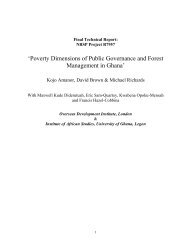The Gambian Tourist Value Chain and Prospects for Pro-Poor Tourism
The Gambian Tourist Value Chain and Prospects for Pro-Poor Tourism
The Gambian Tourist Value Chain and Prospects for Pro-Poor Tourism
You also want an ePaper? Increase the reach of your titles
YUMPU automatically turns print PDFs into web optimized ePapers that Google loves.
<strong>Tourism</strong> in <strong>The</strong> Gambia: International ‘Best Practice’ in Poverty Reduction & <strong>Pro</strong>-<strong>Poor</strong> Growth Through <strong>Tourism</strong><br />
Draft Report (Friday 22 nd December 2006)<br />
A number of striking points emerge from this analysis of the international package value<br />
chain to <strong>The</strong> Gambia.<br />
<strong>The</strong> positive impact on the local capture of benefits during periods of higher dem<strong>and</strong> is<br />
dramatic. During the peak season hoteliers can capture nearly one-third of the value of the<br />
more expensive peak season package – more than doubling the revenue that accrues per<br />
bed night during the low season. <strong>The</strong> attraction of winter sun holidays to international tour<br />
operators is that the peak season coincides with a relatively quiet period <strong>for</strong> European<br />
destinations. Thus premium prices can be charged to customers at a time when the largest<br />
cost component in the value chain (e.g. flights) is lower than during the low summer<br />
season.<br />
Notwithst<strong>and</strong>ing this, tour operators can make reasonable returns during the low season. A<br />
5% return is an aspiration <strong>for</strong> most large operators in the UK (indeed it is a stated corporate<br />
goal <strong>for</strong> First Choice Holidays) – many of whom are currently facing challenging trading<br />
conditions. <strong>The</strong> surpluses reported in this analysis of 6%-7% reflect a composite between the<br />
larger operators (who trade huge volume on smaller margins) <strong>and</strong> the specialist operators<br />
(who generally make healthier margins on smaller turnovers). This analysis does, however,<br />
indicate that tour operators can make reasonable returns during the low season – which is<br />
why international operators are increasingly looking to engage with <strong>The</strong> Gambia on a yearround<br />
basis.<br />
<strong>The</strong> extent of vertical integration of the value chain is very significant <strong>for</strong> a number of the<br />
international tour operators. For instance, most operators have in-house retail operations;<br />
several have their own dedicated aircraft (such as First Choice <strong>and</strong> Thomas Cook) whereas<br />
others utilise charter operations, <strong>and</strong> the Gambia Experience own the Kombo Beach hotel.<br />
All international tour operators have contracts with in-bound tour operators that regulate<br />
the flow of benefits from activities such as excursions. This is how tour operators are able<br />
to extract value throughout the chain.<br />
Table 8 illustrates a number of important points relevant to the tourist sector in <strong>The</strong><br />
Gambia. First, <strong>Gambian</strong> tourism is dominated by two small specialist operators, Gambia<br />
Experience in the UK <strong>and</strong> Olympus in the Netherl<strong>and</strong>s. Small specialist operators need to<br />
make a margin because they are trading low volumes. In contrast, the larger operators can<br />
function at much lower margins because they trade off such large volumes (My Travel<br />
turnover in 2005 was, <strong>for</strong> instance, some thirteen times larger than the Gambia’s national<br />
output).<br />
Table 9: Recent Financial Per<strong>for</strong>mance of International Operators, 2005<br />
Name Gambia Experience First Choice My Travel<br />
Turnover £25.1m £2 578.6m £2 928.9m<br />
Cost of Sales £18.5m £2 221.2m £2 438.4<br />
Administration £3.3m £266.5m £451.0m<br />
Operating <strong>Pro</strong>fit be<strong>for</strong>e tax £2.9m £90.9 - £18.3m<br />
Gross <strong>Pro</strong>fit % 11.5% 3.5% - 0.6%<br />
Share of <strong>Gambian</strong> market 43% 10% 11%<br />
Source: Company Financial Statements<br />
This type of value chain analysis has often been misunderstood by researchers in the past<br />
<strong>and</strong> lead to some rather dramatic claims about the ‘leakage’ of the benefits of tourism<br />
from developing countries. For instance, evidence from the low season value chain could<br />
be taken to suggest that over three-quarters of the benefits from package tourism do not<br />
even register at the destination – being absorbed by the international tour operators <strong>and</strong><br />
airline companies.<br />
Even a proportion of the less than one-quarter of the package that involves stakeholders in<br />
the destination may remain or be repatriated in the <strong>for</strong>m of expatriate salaries, profits <strong>for</strong><br />
<strong>for</strong>eign-owned hotels <strong>and</strong> imported food, beverages, fuel <strong>and</strong> revenues held in off-shore<br />
accounts.<br />
28

















